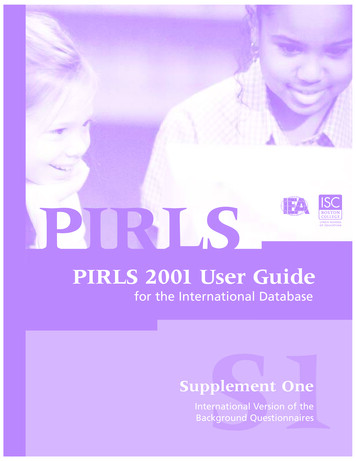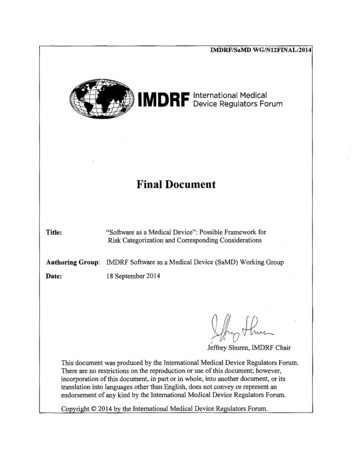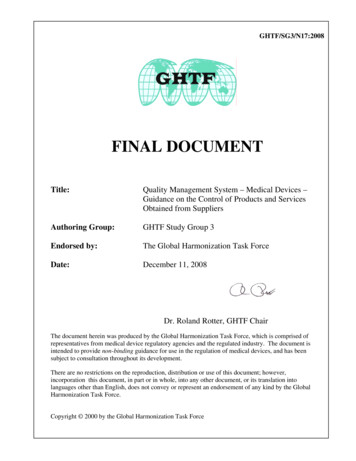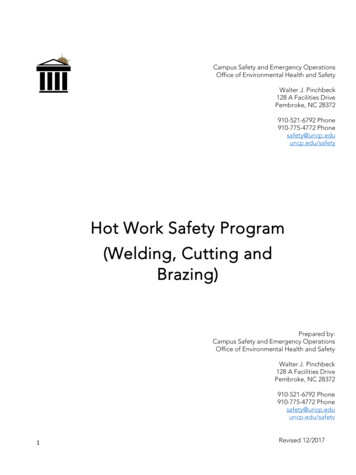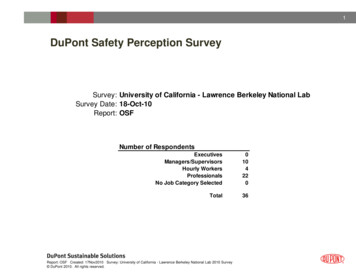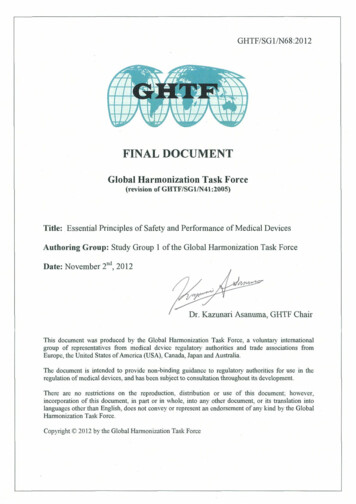
Transcription
Essential Principles of Safety and Performance of Medical DevicesStudy Group 1 Final Document GHTF/SG1/N68:2012Table of ContentsPreface. 41Introduction . 52Rationale, Purpose and Scope . 52.1Rationale . 52.2Purpose. 62.3Scope . 63References . 64Definitions . 75Safety and Performance of Medical Devices – General Principles . 86Essential Principles applicable to all Medical Devices including IVD Medical Devices. 87Essential Principles applicable to Medical Devices other than IVD Medical Devices. 9B1Chemical, physical and biological properties . 9B2Infection and microbial contamination . 10B3Medical devices incorporating a substance considered to be a medicinal product/drug. 11B4Medical devices incorporating materials of biological origin . 11B5Environmental properties . 12B6Devices with a diagnostic or measuring function . 13B7Protection against radiation . 13B8Medical devices that incorporate software and standalone medical device software . 14B9Active medical devices and devices connected to them . 14B10 Protection against mechanical risks . 15B11 Protection against the risks posed to the patient or user by supplied energy or substances . 16B12 Protection against the risks posed by medical devices intended by the manufacturer for use by laypersons . 16B13 Label and Instructions for Use . 16B14 Clinical evaluation . 168Essential Principles applicable to IVD Medical Devices . 17C1Chemical, physical and biological properties . 18C2Infection and microbial contamination . 18C3IVD medical devices incorporating materials of biological origin . 19C4Environmental properties . 20November 2nd, 2012Page 2 of 24
Essential Principles of Safety and Performance of Medical DevicesStudy Group 1 Final Document GHTF/SG1/N68:2012C5Performance characteristics . 21C6Protection against radiation . 21C7IVD medical devices that incorporate software and standalone IVD medical device software . 22C8IVD medical devices connected to, or equipped with, an energy source . 22C9Protection against mechanical and thermal risks . 23C10 Protection against the risks posed by IVD medical devices for self-testing . 23C11 Label and Instructions for Use . 23C12 Performance evaluation including analytical performance and, where appropriate, clinical performance . 24November 2nd, 2012Page 3 of 24
Essential Principles of Safety and Performance of Medical DevicesStudy Group 1 Final Document GHTF/SG1/N68:2012PrefaceThe document herein was produced by the Global Harmonization Task Force, avoluntary group of representatives from medical device regulatory authorities and theregulated industry. The document is intended to provide non-binding guidance for use in theregulation of medical devices, and has been subject to consultation throughout itsdevelopment.There are no restrictions on the reproduction, distribution, translation or use of thisdocument. However, incorporation of this document, in part or in whole, into any otherdocument does not convey or represent an endorsement of any kind by the GlobalHarmonization Task Force.November 2nd, 2012Page 4 of 24
Essential Principles of Safety and Performance of Medical DevicesStudy Group 1 Final Document GHTF/SG1/N68:20121IntroductionThe primary way in which the GHTF achieves its goals is through the production of aseries of guidance documents that together describe a global regulatory model for medicaldevices. The purpose of such guidance is to harmonize the documentation and proceduresthat are used to assess whether a medical device conforms to the regulations that apply ineach jurisdiction. Eliminating differences between jurisdictions decreases the cost of gainingregulatory compliance and allows patients earlier access to new technologies and treatments.This document has been developed to encourage and support global convergence ofregulatory systems. It is intended for use by Regulatory Authorities (RAs), ConformityAssessment Bodies (CABs) and industry, and will provide benefits in establishing, in aconsistent way, an economic and effective approach to the control of medical devices in theinterest of public health. It seeks to strike a balance between the responsibilities of RAs tosafeguard the health of their citizens and their obligations to avoid placing unnecessaryburdens upon the industry.This guidance document describes fundamental design and manufacturingrequirements, referred to as ‘Essential Principles of Safety and Performance’ that, when met,indicate a medical device is safe and performs to its specification. It supersedes an earlierversion with the same title dated June 3rd, 2005 (GHTF/SG1/N041:2005). It has beenchanged to: respond to technical advancements since 2005 such as requirements for devicesincorporating materials of biological origin, requirements for performanceevaluation, and medical software; and provide a separate section within the document for IVD medical devices.Where other guidance documents within the series are referenced within this text,their titles are italicised for clarity.Study Group 1 of the Global Harmonization Task Force (GHTF) has prepared thisguidance document. Comments or questions should be directed to the Chair of GHTF StudyGroup 1 whose contact details may be found on the GHTF web page 1.2Rationale, Purpose and Scope2.1 RationaleThe worldwide adoption of fundamental design and manufacturing requirements formedical devices that, when met, provide assurance the device is safe and performs to itsspecification, offers significant benefits to the manufacturer, user, patient or consumer, and toRegulatory Authorities. Eliminating or reducing differences between jurisdictions decreasesthe cost of gaining regulatory compliance and allows patients earlier access to newtechnologies and treatments.1www.ghtf.orgNovember 2nd, 2012Page 5 of 24
Essential Principles of Safety and Performance of Medical DevicesStudy Group 1 Final Document GHTF/SG1/N68:20122.2 PurposeTo identify and describe six general essential principles of safety and performancethat apply to all medical devices, including IVD medical devices.To identify and describe additional essential principles of safety and performancewhich need to be considered during the design and manufacturing process, the first group ofwhich is relevant to: medical devices other than IVD medical devices,and the second group to IVD medical devices only.Note: during the design process, the manufacturer 2 selects which of the listed designand manufacturing principles apply to the particular medical device and documents thereasons for excluding others.2.3 ScopeThis document applies to all products that fall within the definition of a medicaldevice that appears within the GHTF document Definition of the Terms ‘Medical Device’ and‘In Vitro Diagnostic (IVD) Medical Device’.3ReferencesGHTF final documents 3GHTF/SG1/N78:2012 Principles of Conformity Assessment for Medical Devices.GHTF/SG1/N70:2011 Label and Instructions for Use for Medical Devices.GHTF/SG1/N044:2008 Role of Standards in the Assessment of Medical Devices.GHTF/SG1/N055:2009 Definitions of the Terms Manufacturer, Authorised Representative,Distributor and Importer.GHTF/SG1/N046:2008 Principles of Conformity Assessment for In Vitro Diagnostic (IVD)Medical DevicesGHTF/SG1/N071:2012 Definition of the Terms ‘Medical Device’ and ‘In Vitro Diagnostic(IVD) Medical Device’GHTF/SG5/N1R8:2007 Clinical Evidence – Key Definitions and ConceptsGHTF/SG5/N2R8:2007 Clinical Evaluation.2For the definition of manufacturer see GHTF/SG1/N055:2009 Definitions of the Terms Manufacturer,Authorised Representative, Distributor and Importer.3The listed documents are subject to periodic review and may be superseded by later documents. The reader isencouraged to refer to the GHTF website www.ghtf.org to confirm whether the referenced documents remaincurrent.November 2nd, 2012Page 6 of 24
Essential Principles of Safety and Performance of Medical DevicesStudy Group 1 Final Document GHTF/SG1/N68:2012GHTF/SG5/N3:2010 Clinical InvestigationsGHTF/SG5/N6:2012 Clinical Evidence for IVD Medical Devices - Key Definitions andConceptsGHTF/SG5/N7:2012 Clinical Evidence for IVD Medical Devices - Scientific ValidityDetermination and Performance Evaluation.GHTF/SG5/N8:2012 Clinical Performance Studies for In Vitro Diagnostic Medical DevicesInternational standardsISO 14971:2007 Medical Devices – Application of Risk Management to Medical Devices.ISO/TR 16142:2006 Medical Devices – Guidance on the Selection of Standards in Support ofthe Recognized Essential Principles of Safety and Performance of Medical Devices.4DefinitionsAnalytical performance: the ability of an IVD medical device to detect or measure aparticular analyte.Clinical data: safety and/or performance information that are generated from the clinical useof a medical device.Clinical evaluation: the assessment and analysis of clinical data pertaining to a medicaldevice to verify the clinical safety and performance of the device when used asintended by the manufacturer.Clinical evidence for an IVD medical device: all the information that supports the scientificvalidity and performance for its use as intended by the manufacturer.Clinical performance of an IVD medical device: the ability of an IVD medical device toyield results that are correlated with a particular clinical condition/physiological statein accordance with target population and intended user.Harm: physical injury or damage to the health of people or damage to property or theenvironmentHazard: potential source of harm.Intended use / purpose: the objective intent of the manufacturer regarding the use of aproduct, process or service as reflected in the specifications, instructions andinformation provided by the manufacturerIn Vitro Diagnostic (IVD) medical device: refer to GHTF/SG1/N71:2012 Definition of theTerms ‘Medical Device’ and ‘In Vitro Diagnostic (IVD) Medical Device’.IVD medical device for self-testing: any IVD medical device intended by the manufacturerfor use by lay persons.Lay person: individual that does not have formal training in a relevant field or discipline.November 2nd, 2012Page 7 of 24
Essential Principles of Safety and Performance of Medical DevicesStudy Group 1 Final Document GHTF/SG1/N68:2012Manufacturer: refer to GHTF/SG1/N055:2009 Definitions of the Terms Manufacturer,Authorised Representative, Distributor and Importer.Medical device: refer to GHTF/SG1/N71:2012 Definition of the Terms ‘Medical Device’ and‘In Vitro Diagnostic (IVD) Medical Device’.Performance evaluation for an IVD medical device: assessment and analysis of data toestablish or verify the performance of an IVD medical device.Regulatory Authority (RA): a government agency or other entity that exercises a legal rightto control the use or sale of medical devices within its jurisdiction, and may takeenforcement action to ensure that medical products marketed within its jurisdictioncomply with legal requirements.Risk: combination of the probability of occurrence of harm and the severity of that harm.Specimen: the discrete portion of a body fluid or tissue or other sample associated with thebody taken for examination, study, or analysis of one or more quantity orcharacteristic to determine the character of the whole.5Safety and Performance of Medical Devices – General PrinciplesA manufacturer of a medical device is expected to design and manufacture a productthat is safe and performs as intended. This guidance document describes fundamental designand manufacturing requirements, referred to as ‘Essential Principles of Safety andPerformance’, to ensure this outcome. This document is structured to provide generalessential principles that apply to all medical devices including IVD medical devices (Section6) and is then separated into two dedicated sections, one for medical devices other than IVDmedical devices (Section 7) and the other for IVD medical devices only (Section 8).The medical device manufacturer’s design and manufacturing activities are under thecontrol of its quality management system. Conformity of the device to all the applicableEssential Principles will be demonstrated and assessed according to procedures designated bythe Regulatory Authority and described in other GHTF guidance.6Essential Principles applicable to all Medical Devices including IVDMedical DevicesA1Medical devices should be designed and manufactured in such a way that, when usedunder the conditions and for the purposes intended and, where applicable, by virtue ofthe technical knowledge, experience, education or training, and the medical andphysical conditions of intended users, they will perform as intended by themanufacturer and not compromise the clinical condition or the safety of patients, or thesafety and health of users or, where applicable, other persons, provided that any riskswhich may be associated with their use constitute acceptable risks when weighedagainst the benefits to the patient and are compatible with a high level of protection ofhealth and safety.A2The solutions adopted by the manufacturer for the design and manufacture of thedevices should conform to safety principles, taking account of the generallyNovember 2nd, 2012Page 8 of 24
Essential Principles of Safety and Performance of Medical DevicesStudy Group 1 Final Document GHTF/SG1/N68:2012acknowledged state of the art. When risk reduction is required, the manufacturershould control the risks so that the residual risk associated with each hazard is judgedacceptable. The manufacturer should apply the following principles in the priorityorder listed: identify known or foreseeable hazards and estimate the associated risks arisingfrom the intended use and foreseeable misuse; eliminate risks as far as reasonably practicable through inherently safe designand manufacture; reduce as far as reasonably practicable the remaining risks by taking adequateprotection measures, including alarms; and inform users of any residual risks.A3Medical devices should achieve the performance intended by the manufacturer and bedesigned and manufactured in such a way that, during normal conditions of use, theyare suitable for their intended purpose.A4The characteristics and performances referred to in Clauses A1, A2 and A3 should notbe adversely affected to such a degree that the health or safety of the patient or the userand, where applicable, of other persons are compromised during the lifetime of thedevice, as indicated by the manufacturer, when the device is subjected to the stresseswhich can occur during normal conditions of use and has been properly maintained inaccordance with the manufacturer’s instructions.A5Medical devices should be designed, manufactured and packaged in such a way thattheir characteristics and performances during their intended use will not be adverselyaffected by transport and storage conditions (for example, fluctuations of temperatureand humidity) taking account of the instructions and information provided by themanufacturer.A6All known and foreseeable risks, and any undesirable effects, should be minimised andbe acceptable when weighed against the benefits of the intended performance ofmedical devices during normal conditions of use.7Essential Principles applicable to Medical Devices other than IVDMedical DevicesThe design and manufacturing principles listed in this Section of the document areadditional to the general principles of safety and performance listed in Section 6.B1Chemical, physical and biological propertiesB1.1The devices should be designed and manufactured in such a way as to ensure thecharacteristics and performance referred to in Section 6. Particular attention shouldbe paid to: the choice of materials used, particularly as regards toxicity and, whereappropriate, flammability,November 2nd, 2012Page 9 of 24
Essential Principles of Safety and Performance of Medical DevicesStudy Group 1 Final Document GHTF/SG1/N68:2012 the compatibility between the materials used and biological tissues, cells, andbody fluids taking account of the intended purpose of the device. the choice of materials used, reflecting, where appropriate, matters such ashardness, wear and fatigue strength.B1.2The devices should be designed, manufactured and packaged in such a way as tominimize the risk posed by contaminants and residues to the persons involved in thetransport, storage and use of the devices and to patients, taking account of theintended purpose of the device. Particular attention should be paid to tissues exposedand to the duration and frequency of exposure.B1.3The devices should be designed and manufactured in such a way that they can be usedsafely with the materials, substances and gases with which they enter into contactduring their normal use or during routine procedures; if the devices are intended toadminister medicinal products they should be designed and manufactured in such away as to be compatible with the medicinal products concerned according to theprovisions and restrictions governing these products and that their performance ismaintained in accordance with the intended use.B1.4The devices should be designed and manufactured in such a way as to reduce as far asreasonably practicable and appropriate the risks posed by substances that may leach orleak from the device. Special attention shall be given to substances which arecarcinogenic, mutagenic or toxic to reproduction.B1.5Devices should be designed and manufactured in such a way as to reduce as far asreasonably practicable and appropriate risks posed by the unintentional ingress oregress of substances into or from the device taking into account the device and thenature of the environment in which it is intended to be used.B2Infection and microbial contaminationB2.1The devices and manufacturing processes should be designed in such a way as toeliminate or to reduce as far as reasonably practicable and appropriate the risk ofinfection to patients, users and, where applicable, other persons. The design should: allow easy handling,and, where necessary: reduce as far as reasonably practicable and appropriate any microbial leakagefrom the device and/or microbial exposure during use, prevent microbial contamination of the device or specimen, where applicable,by the patient, user or other person.B2.2Devices labelled as having a special microbiological state should be designed,manufactured and packaged to ensure they remain so when placed on the market andremain so under the transport and storage conditions specified by the manufacturer.B2.3Devices delivered in a sterile state should be designed, manufactured and packaged ina non-reusable pack, and/or according to appropriate procedures, to ensure that theyNovember 2nd, 2012Page 10 of 24
Essential Principles of Safety and Performance of Medical DevicesStudy Group 1 Final Document GHTF/SG1/N68:2012are sterile when placed on the market and remain sterile, under the transport andstorage conditions indicated by the manufacturer, until the protective packaging isdamaged or opened.B2.4Devices labelled either as sterile or as having a special microbiological state shouldhave been processed, manufactured and, if applicable, sterilized by appropriate,validated methods.B2.5Devices intended to be sterilized should be manufactured in appropriately controlled(e.g. environmental) conditions.B2.6Packaging systems for non-sterile devices should maintain the integrity andcleanliness of the product and, if the devices are to be sterilized prior to use, minimizethe risk of microbial contamination; the packaging system should be suitable takingaccount of the method of sterilization indicated by the manufacturer.B2.7The labelling of the device should distinguish between identical or similar productsplaced on the market in both sterile and non-sterile condition.B3Medical devices incorporating a substance considered to be a medicinalproduct/drugThis section is not intended to provide guidance on ‘combination products’ as a wholesince definitions have yet to be harmonized and practice varies between different jurisdictions.B3.1Where a device incorporates, as an integral part, a substance which, if used separately,may be considered to be a medicinal product/drug as defined in the relevantlegislation that applies within that jurisdiction and which is liable to act upon the bodywith action ancillary to that of the device, the safety, quality and performance of thedevice as a whole should be verified, as well as the safety, quality and efficacy of thesubstance in the specific application,B4Medical devices incorporating materials of biological originThis section is not intended to provide guidance on ‘combination products’ as a wholesince definitions have yet to be harmonized and practice varies between different jurisdictions.B4.1In some jurisdictions products incorporating tissues, cells and substances of animalorigin may be considered medical devices. In this case, such tissues, cells andsubstances should originate from animals that have been subjected to veterinarycontrols and surveillance adapted to the intended use of the tissues. Nationalregulations may require that the manufacturer and/or the Regulatory Authority retaininformation on the geographical origin of the animals. Processing, preservation,testing and handling of tissues, cells and substances of animal origin should be carriedout so as to provide optimal safety for patients, users and, where applicable, otherpersons. In particular, safety with regard to viruses and other transmissible agentsshould be addressed by implementation of validated methods of elimination orinactivation in the course of the manufacturing process.B4.2In some jurisdictions products incorporating human tissues, cells and substances maybe considered medical devices. In this case, the selection of sources, donors and/orNovember 2nd, 2012Page 11 of 24
Essential Principles of Safety and Performance of Medical DevicesStudy Group 1 Final Document GHTF/SG1/N68:2012substances of human origin, the processing, preservation, testing and handling oftissues, cells and substances of such origin should be carried out so as to provideoptimal safety for patients, users and, where applicable, other persons. In particular,safety with regard to viruses and other transmissible agents should be addressed byimplementation of validated methods of elimination or inactivation in the course ofthe manufacturing process.B4.3In some jurisdictions products incorporating cells and substances of microbial originmay be considered medical devices. In this case, processing, preservation, testing andhandling of cells and substances should be carried out so as to provide optimal safetyfor patients, users and, where applicable, other persons. In particular, safety withregard to viruses and other transmissible agents should be addressed byimplementation of validated methods of elimination or inactivation in the course ofthe manufacturing process.B5Environmental propertiesB5.1If the device is intended for use in combination with other devices or equipment thewhole combination, including the connection system should be safe and should notimpair the specified performance of the devices. Any restrictions on use applying tosuch combinations should be indicated on the label and/or in the instructions for use.Connections which the user has to handle, such as fluid, gas transfer or mechanicalcoupling, should be designed and constructed in such a way as to minimize allpossible risks from incorrect connection.B5.2Devices should be designed and manufactured in such a way as to remove or reduceas far as reasonably practicable and appropriate:B5.2.1the risk of injury to the patient, user or other persons in connection with theirphysical and ergonomic features;B5.2.2the risk of use error due to the ergonomic features, human factors and theenvironment in which the device is intended to be used;B5.2.3risks connected with reasonably foreseeable external influences orenvironmental conditions, such as magnetic fields, external electrical andelectromagnetic effects, electrostatic discharge, radiation associated withdiagnostic or therapeutic procedures, pressure, humidity, temperature orvariations in pressure and acceleration;B5.2.4the risks associated with the use of the device when it comes into contact withmaterials, liquids, and gases to which it is exposed during normal conditions ofuse;B5.2.5the risk associated with the possible negative interaction between software andthe environment within which it operates and interacts;B5.2.6the risks of accidental penetration of substances into the device;B5.2.7the risks of reciprocal interference with other devices normally used in theinvestigations or for the treatment given;November 2nd, 2012Page 12 of 24
Essential Principles of Safety and Performance of Medical DevicesStudy Group 1 Final Document GHTF/SG1/N68:2012B5.2.8risks arising where maintenance or calibration are not possible (as withimplants), from ageing of materials used or loss of accuracy of any measuringor control mechanism.B5.3Devices should be designed and manufactured in such a way as to minimize the risksof fire or explosion during normal use and in single fault condition. Particularattention should be paid to devices whose intended use includes exposure to or use inassociation with flammable substances or substances which could cause combustion.B5.4Devices should be designed and manufactured in such a way that adjustment,calibration, and maintenance, where such is necessary to achieve the performancesintended, can be done safely.B5.5Devices should be designed and manufactured in such a way as to facilitate the safedisposal of any waste substances.B6Devices with a diagnostic or measuring functionB6.1Diagnostic devices and devices with a measuring function, should be designed andmanufactured in such a way as to provide sufficient accuracy, precision and stabilityfor their intended purpose of the device, based on appropriate scientific and technicalmethods. The limits of accuracy should be indicated by the manufacturer.B6.2Any measurement, monitoring or display scale should be designed in line withergonomic principles, taking account of the intended purpose of the device.B6.3Wherever possible values expressed numerically should be in commonly accepted,standardised units, and understood by the users of the device.Note: While SG1 generally supports convergence on the global use of internationallystandardised measurement units, considerations of safety, user familiarity, andestablished clinical practice may justify the use of other recognised measurement units.B7Protection against radiationB7.1General B7.2Devices should be designed and manufactured and packaged in such a way thatexposure
GHTF/SG5/N7:2012 Clinical Evidence for IVD Medical Devices - Scientific Validity Determination and Performance Evaluation. GHTF/SG5/N8:2012 Clinical Performance Studies for In Vitro Diagnostic Medical Devices International standards ISO 14971:2007 Medical Devices - Application of Risk Management to Medical Devices. ISO/TR 16142:2006 Medical Devices - Guidance on the Selection of Standards .

